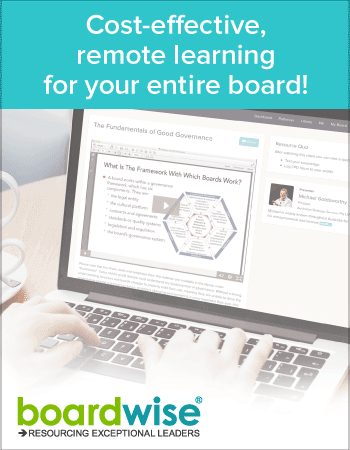Take Your Board to the Next Level: Powerful Agenda Best Practices
-
meetings
Take Your Board to the Next Level: Powerful Agenda Best Practices
Setting a clear, focused agenda is one of the most important things you can do to ensure your board meetings stay on track and achieve their objectives.
A well-planned agenda acts as a roadmap for the meeting, keeping conversations productive, focused, and moving towards constructive outcomes.
Why a Solid Agenda Matters
Taking the time to create a solid, detailed agenda and distributing it to attendees well in advance of the board meeting sets everyone up for success.
Board members can review the agenda ahead of time and prepare by gathering their thoughts, notes, questions, or any other relevant information pertaining to the slated discussions. This level of preparation leads to more engaged and informative dialogue during the actual meeting.
With an agenda clearly laying out the topics to be covered and the timeframe allotted to each one, the chair can more easily facilitate the meeting and keep things on schedule.
When you have a packed slate of issues to work through, a clear agenda helps ensure you get through everything efficiently. Without one, meetings tend to drag, important items get shortchanged, and you struggle to make decisions.
Key Areas to Address in the Agenda
The agenda provides a basic structure, but should also include enough detail about each topic so board members know what to expect. For each discussion item, aim to provide some background on the specific issue and what you want to achieve by the end.
For example, rather than just listing “New Budget Approval”, expand on key details like the context around why a new budget is needed, timeline, the process taken to develop it, and what specifically you want the board to review or approve during the meeting.
Be sure to leave reasonable time for discussion of each item rather than cramming the agenda too tightly. Build flexibility into the schedule as well in case certain discussions run long.
Here are some of the key sections to include on a thorough, well-planned board meeting agenda:
- Welcome and Introductions
- Official call to order and welcome
- Attendance
- Guest introductions
- Staff introductions
- Consent Agenda
A consent agenda quickly approves routine items in one motion without discussion. This might include:
- Previous meeting minutes
- Committee reports
- Executive director report
- Finance report
- Priority Business Items
Remember to provide sufficient background and explain what input or decisions you require from the board.
Discussions and Updates
Address any other issues needing attention but not necessarily final decisions. Includes things like:
- Program updates
- Fundraising updates
- Personnel updates
- Meeting Finalisation
- Public comment period
- Meeting recap
- Review actions to be taken
- Next meeting date/time
- Adjournment
Following this basic structure keeps your board focused on the information and conversations that really matter and ensures you make solid headway on priorities.
Encourage Engagement
An agenda provides the all-important framework, but execution is just as critical for an effective board meeting. You want to encourage active participation from all board members while keeping things focused and moving forward.
Create opportunities within each agenda item for board member contributions by directly asking for their thoughts, opinions, and questions. Foster open dialogue where everyone feels comfortable honestly sharing ideas or concerns.
When debates arise, aim to find common ground if possible. Identify areas of agreement to build unity behind decisions.
Come Prepared
For the board to provide meaningful guidance and make informed decisions, they need adequate information well in advance of meetings. Develop board packs containing relevant reports, proposals, data, or other materials tied to agenda items.
Provide context around the issues to be discussed so the board understands underlying needs, constraints, stakeholders impacted, and so on.
Ensure packs are distributed with enough time for the board to review materials, this sets them up to engage productively in person.
Keep Things Moving
The chair plays a pivotal role in keeping the agenda on track and moving the meeting efficiently from one topic to the next.
The chair plays a key role in:
- Politely reining in meandering debates that veer too far off course.
- Nudging discussions along that hit a lull.
- If certain issues end up requiring deeper debate, suggesting tabling them for further analysis or smaller group discussions rather than eating up valuable full board time.
- Identifying when consensus is emerging around key decisions and formalise conclusions so you can shift gears to the next agenda item.
- Periodically summarising what has been covered and decided.
Evaluate and Adjust
Use the end of board meetings to quickly evaluate what worked well and where there is room for improvement in terms of process.
It is worth gathering anonymous feedback about the effectiveness of meetings and level of preparedness. This allows you to:
- Monitor whether you are making good progress on priorities established for the board.
- Implement changes to try resolving recurrent issues.
- Revise how you structure agendas, add in more board education, adjust meeting frequency or length, or make other tweaks aimed at boosting productivity.
Don’t just restrict your board to meeting evaluations, ensure you undertake regular whole board evaluations.
The Bottom Line on Meeting Best Practices
Strong board meetings don’t just happen automatically. They require vigilant planning, communication, and coordination rooted in well-crafted agendas.
Following solid practices around agenda preparation, facilitation, and evaluation ensures your meetings consistently advance your mission.
Resources
Free Board Meeting Assessment Template
How to Present to the Board of Directors
Who Should Control the Reporting of Information to the Board?
Dealing with Difficult Directors in your Boardroom
Frequently Asked Questions
What are the qualities of a good agenda?
A good agenda clearly states the key topics to be discussed in order of priority importance, indicates a time duration and person responsible or accountable for leading each topic, and importantly, is shared well in advance with all participants so everyone has adequate opportunity to review the agenda items and come to the meeting fully prepared. A good agenda fosters productivity by keeping the meeting focused on the most critical issues without getting sidetracked.
What are the 4 P's of a meeting agenda?
The 4 P's of a meeting agenda comprise key components that contribute to a productive meeting agenda:
- Purpose – having a clear set of objectives, goals or intended outcomes provides focus for the meeting;
- Participants – ensuring the appropriate people are present or at minimum informed offers you the right expertise in the room;
- Place – detailing important logistics like the location, dial-in instructions or access links avoids unnecessary delays or confusion; and
- Pace – indicating a reasonable total time limit for the overall meeting as well as approximate durations for each agenda item helps move the discussion along productively.
What is a consent agenda?
A consent agenda contains a grouping of routine, non-controversial, time-consuming agenda items that would likely receive unanimous consent if raised individually for approval. By consolidating and approving this bucket of items together en masse without further debate, a consent agenda streamlines the meeting allowing more time and attention to be spent discussing bigger issues or concerns warranting the committee’s consideration and deliberation.



